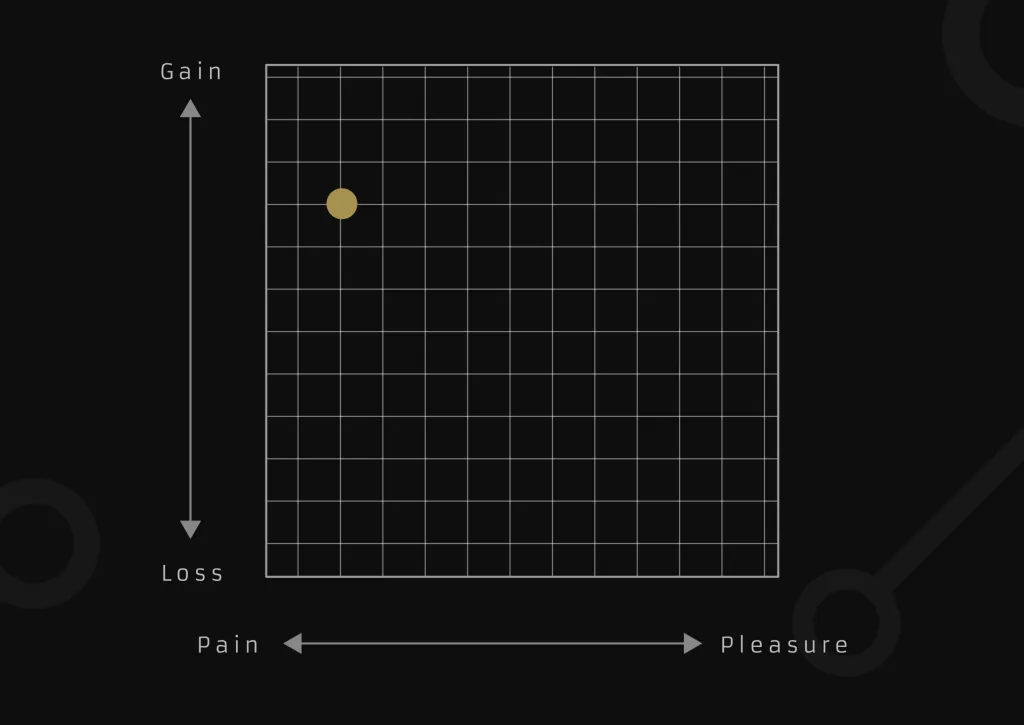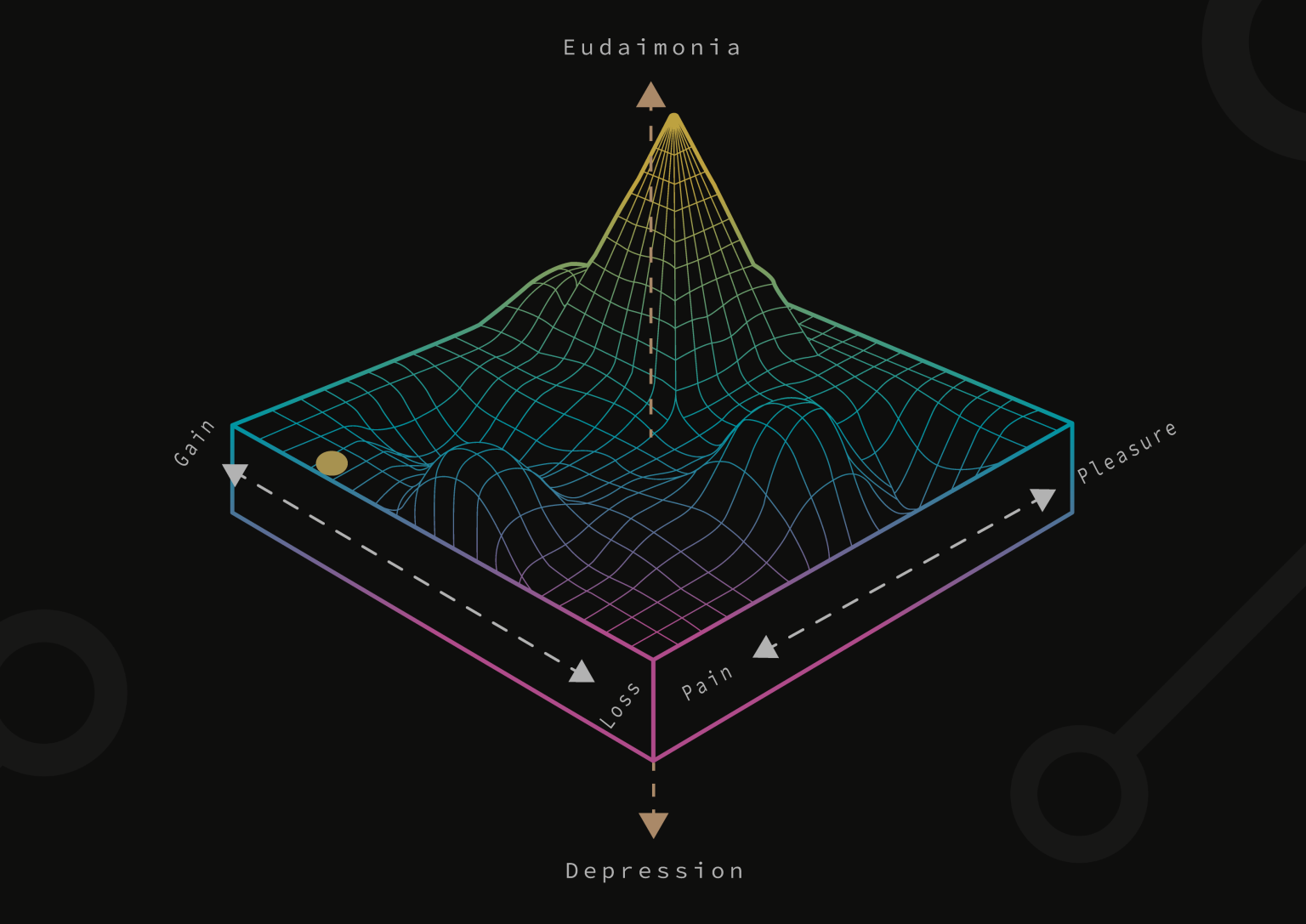The Dimensions of Happiness with Ryan A. Bush
”This third dimension that corresponds to the mountains and the valleys, this is really what I argue is pulling the strings of our happiness.”
– Ryan A. Bush
I had the delight of speaking with Ryan A. Bush, a thinker, designer, and founder of Designing the Mind. He explains his approach to expanding human potential, and how our understanding of happiness needs to be redefined, seeing it not just as pleasure and pain but also through the dimensions of loss/gain and core personal strengths.
We discuss:
- Two common dimensions of happiness
- The third dimension of happiness
- Unpacking the concept of happiness
Two common dimensions of happiness

We’re all familiar with the desire for happiness. Happiness is one of the most regularly touted states of being out there; from mental health gurus to salespeople to our family members, happiness takes on an end-all-be-all importance—almost to the point of desensitization and loss of meaning.
Ryan challenges us to redefine how we look at happiness—to look beyond the measure of pleasure. He dares to pose the question: What if there is more than one dimension of happiness?
“We've got the simplest dimension, which is pleasure and pain. This is the most shallow, basic form of happiness, and we pay a lot of attention to it when we're crafting our lives,” he says.
With pleasure on the right and pain on the left, we see the X-axis of that first dimension take shape. Naturally, we want to sway more towards pleasure than pain. But is that all there is to choose between?
“I introduce a second dimension here that I think—when most of us get a little older—we start paying attention to more and more,” he continues. “And that is the loss/gain dimension, meaning sometimes we will sacrifice pleasure in the moment to achieve long-term success or gain in our circumstances.”
Ryan envisions this dimension as a Y axis, alongside the X axis of the first dimension, creating a chessboard that we use to navigate our lives and happiness. But there’s one problem with this setup.
“I think it's a faulty map in the sense that it doesn't always correspond to our actual happiness,” he says. “People will have all the success and pleasure they could ever imagine in life. Some people win the lottery, and yet they still feel empty.”
The reverse can be true, too—some people will seemingly lose everything but find a deeper sense of happiness and perspective on the other side.
The third dimension of happiness

Ryan wrote his book—Become Who You Are: A New Theory of Self-Esteem, Human Greatness, and the Opposite of Depression—to provide a better map for people to follow. Part of that map introduces a third dimension of happiness.
If we imagine the chessboard map and pull out mountains and valleys, we create a three-dimensional topographical scene that more accurately represents life. Rarely do we operate from a flat, even surface.
The ancient Greeks discussed a state of being called eudaimonia, which stood for a much deeper form of happiness than what we think of today. Alongside this, they also spoke much of virtue—not necessarily virtue in terms of moral purity, but rather as personal strengths.
“Ancient thinkers argued that virtue and eudaimonia are our personal strengths that we're exercising in our lives and the deepest form of happiness, closely interlinked,” Ryan says. “The more virtue you demonstrate, the happier you are in the deepest sense, the less virtue and the least happy you are.”
This virtue—or even admirability—dimension is what Ryan argues is the third dimension responsible for a deeper type of well-being underneath the surface of our external circumstances.
Unpacking the concept of happiness

Putting happiness on a pedestal as the ultimate goal sets us up for disappointment. That’s what makes the pit in our gut when we achieve the goal we believed would finally make us “happy,” and instead, we feel unfulfilled.
We get the promotion, the house, the relationship, the trip we always wanted, the thing we were thinking of when we said, “I’ll be happy once I have XYZ.”
Yet when we get there, it lacks the all-encompassing happiness we told ourselves to expect and strive for. We miss a key fact—happiness is not a destination and isn’t determined by one all-consuming event.
“Instead of saying, ‘What would be the most successful thing to do?‘How can I be as successful as possible?’ We need to start asking, ‘What do I value? What do I admire myself most for doing? What are my greatest strengths?’” Ryan says.
Once we have the answers to those questions, we can determine which path will enable us to bring out those strengths to the highest degree. The way becomes clearer when we’re not laser-focused on the ever-elusive goal of being “Happy.”
What do you value? What are your greatest strengths? Where can you use them to the best of your ability?
“Using this as a map for navigating your life, I think, will much more reliably lead you to actual deep happiness,” he continues.
Ryan’s tips for uncovering personal strengths and values
When you see or read about someone doing something you admire—traits, acts, behaviors—write it down. Keep a list; refer to it often. That list is the model for how to become who you truly are based on what matters to you.
Building the list and modeling your behaviors after what you most admire is what leads you to the right paths, where your strengths thrive and your fulfillment rises.
You can also take the VIA Character Strengths Survey—as well as ask those close to you for their perspective—to help determine which strengths are innate in you as a jumping-off point.
What are three things you could add to your list of admirable traits right now?
Be sure to check out Ryan’s full episode for further insight into deep happiness and learn more at DesigningtheMind.org!








